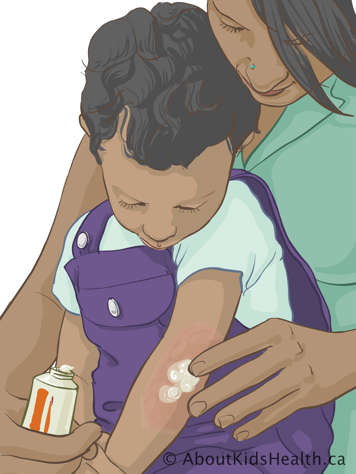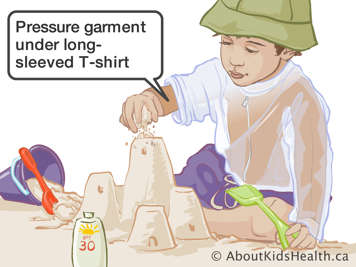What are scar management techniques?
Scar management techniques are different methods you can use to help your child's scar improve in appearance and flexibility. These techniques include:
- Firm massage with blanching pressure (pressing down on the skin until it goes pale)
- silicone
- pressure garments
- splints
- stretching
- laser treatment
Your child’s therapist will explain to you the scar management techniques you need to learn. The ones that are best for your child will depend on:
- the size of the scar
- the thickness of the scar
- where on the body your child's scar is located
- whether the scar affects your child’s movement and activities
This page will give some details about each of the scar management techniques. It will also tell you about how to protect the scar when your child is playing outside.
Firm massage with blanching pressure
Rubbing cream into the scar helps keep it soft and moist so that it does not dry out. Massage also provides pressure on the scar. This can help take away the itchy feeling.

How to massage
- It is best to use a water-based cream. A cream is water-based when the main (first) ingredient on the label is water or aqua.
- Slowly rub the cream in circles with your fingertips.
- Try to cover all areas of the scar with the cream.
- When massaging, be sure to press hard enough so that the scar turns pale under your fingertips.
- Be careful not to massage over any open sores.
Massage should be done two to three times every day. You can massage more often if the scar becomes dry or itchy.
Other kinds of creams and oils
Although water-based creams are recommended, you can use any cream or oil you prefer, as long as the scar is well moisturized. If the scar dries out, it can become very itchy and uncomfortable.
Try not to use perfumed lotions. The skin may react to them and become itchy, and a sore red rash may appear. Choose one cream or oil and keep using it. If you keep changing products and your child gets a rash, you will not know what caused it.
More expensive creams do not work any better than less expensive ones.
Silicone
Silicone can help reduce scarring and improve scars that are already formed. Silicone can come in two forms, gels and sheets. Silicone can be purchased online or at your local pharmacy.
Silicone should be applied to clean, dry and non-greasy skin. It should never be used over open wounds. Silicone gel is best used on the hands, face and over joints that move. Silicone sheets may require tight clothing or pressure garments to keep them in place.
Your child’s health-care team will make silicone recommendations if required.
Pressure garments
Pressure garments are custom-made clothes made from an elastic material. They fit tightly over the scar. This helps keep scars flatter and less itchy. Your child will wear pressure garments underneath their regular clothes.

Pressure garments are not for every scar
Your child’s therapist or surgeon will let you know if your child needs to wear pressure garments and will explain why.
Your child will need to wear their pressure garments until the scars are flat and soft. They may need to wear garments 20+ hours a day for up to one year. Garments need to be replaced every three months as your child grows and wears them out. Your child’s occupational therapist will keep an eye on how well the garment fits as your child grows.
The garments allow the skin to breathe, but they can be warm in summer. A fan at night and playing in the shade outdoors may help.
Splints
A splint is a hard-plastic brace. Its job is to stretch out your child's scar.
Splints are not for every scar
Your child’s therapist will let you know if your child needs a splint. Your child may need to wear one if the scar covers joints. Joints are the areas of the body that move such as the ankles, knees, elbows, hands, shoulders, hips and neck.
Sometimes when scars heal, the skin gets tight. This makes it hard to move these joints. A splint will help keep the scar stretched out. It is usually used along with massage and stretches.
Wearing the splint
Your child’s therapist will give you instructions about when your child should wear the splint and how to keep it clean.
Stretching
Scars tend to shrink (contract) and become tight for the first six to nine months. Eventually, scars will soften and relax over the next six to nine months. This is a long process and can limit your child's movement. This is especially true if the scarred area crosses over joints. It is very important to stretch out this tight skin up to three times per day. Your child’s therapist will show you specific stretches to do with your child.
Laser treatment
There are two lasers that can help treat burn scars: pulsed dye lasers (PDLs) and carbon dioxide (CO2) lasers. A PDL can help make scars less red and also help with itch. A CO2 laser can be used to help soften scars and make them more pliable. The laser treatments can be painful, so your child will likely be given sedation in order to keep them comfortable throughout the procedure. Your child will usually be discharged home with some simple dressings in place that can be removed in 24-48 hours.
Open sores and rashes
While they are healing, areas of the skin can open or blister because the skin is very fragile. This is normal. If you find an open area bigger than the size of a small coin (such as a dime or a quarter), be sure to keep it clean and notify your child’s health-care team.
What to do:
- Wash the area with soap and water during your child’s usual bath routine.
- Put petroleum jelly and gauze on the sore. This will keep it clean and dry.
- If your child is wearing a pressure garment, take care as you put the garment over the gauze. You want to avoid wrinkling the dressing.
What do you do if your child gets a skin rash?
Your child may get a red sore rash because their skin is sensitive to one or more of the following:
- lotions
- soaps
- pressure garments
If you notice a rash, call your child’s health-care team.
Outdoor activities
Swimming
Your child may swim in any pools or lakes as long as all areas of the skin are healed. There should be no big open areas on the skin.
Chlorine tends to dry out scars, so be sure to rinse off all pool water and put extra cream on the scar when your child comes out of the pool.
No direct sunlight for at least a year
Your child should avoid having sunlight shine directly on the scar for the first summer after the injury. Use waterproof sun block lotion on all skin that is exposed to the sun, especially on the scar. Make sure the label says SPF 30 or higher and that the sun block has UVA and UVB protection.
New skin/scars burn easily. Try to keep the scar protected from the sun with a hat, clothing, and sunscreen. When swimming, have your child wear a sun shirt or bathing suit with SPF to cover the scar. If the new skin gets tanned, it will not fade, and there will always be a dark area. The sun can also cause little itchy red dots to appear on your child's skin.
During the second and following summers, you can use sunscreen to protect their skin.
